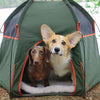Free Dog Parks Near Me Location Tool
Dog parks are probably the best area for the dog, other than the home. Dogs, more than any other pets, love to run free and play off-leash, and a dog park is a fenced area for large and small dogs, built just for that purpose. Leash parks that provide more social distancing have been appearing more often.
What should I know before heading to the dog park?
For pet owners, these parks are a valuable dog-friendly resource. They provide a secure place to exercise and socialize while connecting you instantly with a local community of dog-friendly pet parents. Make sure to start in the leash area and progress to going leash-free in an open space.
You can have a chat with fellow dog lovers while your pet socializes in its way. Your dog will be running with no leash, making friends, and generally enjoying the time.
Along with the joy and excitement, new pet parents heading to the pet park for the first time may find off-leash play more like work. It's essential to understand park etiquette before setting foot within the gate.
You can have a chat with fellow dog lovers while your pet socializes in its way. Your dog will be running with no leash, making friends, and generally enjoying the time.
Along with the joy and excitement, new pet parents heading to the pet park for the first time may find off-leash play more like work. It's essential to understand park etiquette before setting foot within the gate.
I take long walks with my dog, is that equivalent to time at the animal park?
When it comes to socialization, unfortunately, a walk won't offer the same benefits as time spent in the park. They don't tire most dogs out, even two-hour treks. Second of all, they don't let the dog socialize enough, even with other dogs.
How should I come prepared to bring my pet to the animal park?
Dog owners should make sure their pup has a collar on with tags. Bring doggie bags and water, as your animal will likely be thirsty after playing at the park.
Of course, dress your pet in our amazing gear at Discount Pet Deals.
For the dog owner, be relaxed and dress comfortably and wear closed-toed shoes. It's not a pleasant feeling when something squishes into your sandal without you realizing it. And you (and your dog) can work up a sweat playing fetch!
Of course, dress your pet in our amazing gear at Discount Pet Deals.
For the dog owner, be relaxed and dress comfortably and wear closed-toed shoes. It's not a pleasant feeling when something squishes into your sandal without you realizing it. And you (and your dog) can work up a sweat playing fetch!
Should I bring treats to the dog park?
A toy or treats can prompt other dogs at the park to crowd you and your dog, so it's best to leave food and unique toys home. Your dog park should have drinking fountains.
Try to keep games of fetch short if you decided to bring a ball. It tends to promote unfriendly and obsessive guarding while excluding needed social releases like butt sniffs, chasing, wrestling, and generally hanging out.
Try to keep games of fetch short if you decided to bring a ball. It tends to promote unfriendly and obsessive guarding while excluding needed social releases like butt sniffs, chasing, wrestling, and generally hanging out.
Is it OK to bring a puppy to the dog park if it's vaccinated?
Don't believe the fear-mongering regarding that there is no place for a puppy in a pet park! If aggressive large dogs or dogs are playing too roughly, and if the puppy is exceptionally tiny, we want to be careful.
Problems are infrequent with well-socialized dogs; they help puppies by teaching social norms and manners. The sooner pups can interact with a wide range of other small dogs of their size, the better.
Bringing puppies into the dog areas after six months of age is good. You make sure to make the first visits short as not to overwhelm them, ideally when there are not too many dogs. To prepare your puppy for the park, start them out with puppy social hours.
Interacting with other puppies instead of a group of dogs will only help to a point. Puppy groups are most helpful when other pups can't do otherwise. Otherwise, they're like having a bunch of kids together with no adult supervision, no teachers.
Problems are infrequent with well-socialized dogs; they help puppies by teaching social norms and manners. The sooner pups can interact with a wide range of other small dogs of their size, the better.
Bringing puppies into the dog areas after six months of age is good. You make sure to make the first visits short as not to overwhelm them, ideally when there are not too many dogs. To prepare your puppy for the park, start them out with puppy social hours.
Interacting with other puppies instead of a group of dogs will only help to a point. Puppy groups are most helpful when other pups can't do otherwise. Otherwise, they're like having a bunch of kids together with no adult supervision, no teachers.
How often should you bring your pet to an animal park?
Make plenty of time in your schedule for quality time at the park. Physically and intellectually engaged dogs, troublesome behaviors at home tend to decrease — but a once-a-week trip won't cut.
It is essential to socialize your dog outside in a natural environment with lots of other new dogs consistently every day. I see difficulties caused on weekends by dogs who've been pent-up all week.
It is essential to socialize your dog outside in a natural environment with lots of other new dogs consistently every day. I see difficulties caused on weekends by dogs who've been pent-up all week.
Should I let my dog hide when we are at the dog park?
Shy or anxious dogs will sometime hide right behind their owner's feet. This shy behavior can lead to problems down the road, especially if the owner assumes that their dog doesn't enjoy the park and stops bringing them altogether.
Surprisingly, allowing an animal to hide near you could even make issues with other animals worse. Fearful aggressive animals are much more likely to react when within a leg perimeter of their owners because they feel protected.
Far more often than they're protecting their owners, which is what most people think. Instead, owners should encourage their pets to start having positive interactions with other animals at the park.
Surprisingly, allowing an animal to hide near you could even make issues with other animals worse. Fearful aggressive animals are much more likely to react when within a leg perimeter of their owners because they feel protected.
Far more often than they're protecting their owners, which is what most people think. Instead, owners should encourage their pets to start having positive interactions with other animals at the park.
Should my pet play without me at the dog park?
It may be hard to let your pet loose in an inconsistent environment. Pet owners should try to leave their overprotective trends at home. Growlers need to play growl; guarders need to play guard, hunters need to play hunt.
Certain types of play may look more threatening than they are, so it's important to know what kind of behavior is innocent. Reciprocal game is always acceptable. The male chases, then female pursuits; the male puts her neck in his mouth, then she does. Humping or mounting isn't even as bad as it's reputed unless it's one dominant fighter humping another.
Certain types of play may look more threatening than they are, so it's important to know what kind of behavior is innocent. Reciprocal game is always acceptable. The male chases, then female pursuits; the male puts her neck in his mouth, then she does. Humping or mounting isn't even as bad as it's reputed unless it's one dominant fighter humping another.
How do I identify aggressive body language in my pet?
At the park, interpret your dog and his playmate's body language to make sure they're not showing signs of anxiety. Healthy, relaxed play is relatively easy for pet owners to notice.
Look for behaviors between the dogs with lots of back-and-forth movements, almost like a game of tag. If things get a little too hairy, one dog may let out a yelp or give their playmate a signal to provide them with space. Little aggression is generally nothing to worry about.
Troubling body language often looks the opposite — tense and alert. Aggressive body language usually involves a robust and alert body with hair standing behind its neck and carrying the bulk of the body weight toward the front with the animals' ears perked up, tight jaw, possibly baring teeth.
If the dog is showing strong signs of alertness when other dogs approach, it would be a good idea to leave the park.
Look for behaviors between the dogs with lots of back-and-forth movements, almost like a game of tag. If things get a little too hairy, one dog may let out a yelp or give their playmate a signal to provide them with space. Little aggression is generally nothing to worry about.
Troubling body language often looks the opposite — tense and alert. Aggressive body language usually involves a robust and alert body with hair standing behind its neck and carrying the bulk of the body weight toward the front with the animals' ears perked up, tight jaw, possibly baring teeth.
If the dog is showing strong signs of alertness when other dogs approach, it would be a good idea to leave the park.
Do you break up the play between dogs?
Your dog doesn't have to be the perfect pet to do well at the park, as long as he knows the most critical command. "ATTACK," just kidding... I just wanted to keep you awake.
Owners should supervise their dogs at the park so they can break up play frequently, calling their dogs back for a quick check-in. Game-play that has lots of breaks does not result in dog fights most of the time, as situations DE-escalated this way.
Owners should supervise their dogs at the park so they can break up play frequently, calling their dogs back for a quick check-in. Game-play that has lots of breaks does not result in dog fights most of the time, as situations DE-escalated this way.
Should I come between dogs who are fighting?
There are several techniques pet owners can use to break up a fight. It can be hard to do without getting in harm's way. To separate a dog attacking another dog. Approach the dog from behind, and in one motion grabbing their hind legs near the hip area and pulling them away. When you let go, move out fast, as the dog may redirect your bite toward you and never place your hands between two dogs fighting. OUCH!!
Other helpful methods include the old trick of spraying the dogs with a hose, or a loud whistle to startle the dogs. If violence seems to be a regular occurrence with your pet, it's best to seek help from a professional animal trainer or veterinarian behaviorist and get to the root of the issue. You can find a Veterinarian with our Free "Animal Hospital Locator" tool.
So, if you have a pet dog and are looking for a beautiful place for him/her to hang out with other dogs, do take him to a nearby park in your area. Always check your national park or state park rules and regulations.
Other helpful methods include the old trick of spraying the dogs with a hose, or a loud whistle to startle the dogs. If violence seems to be a regular occurrence with your pet, it's best to seek help from a professional animal trainer or veterinarian behaviorist and get to the root of the issue. You can find a Veterinarian with our Free "Animal Hospital Locator" tool.
So, if you have a pet dog and are looking for a beautiful place for him/her to hang out with other dogs, do take him to a nearby park in your area. Always check your national park or state park rules and regulations.
 5 Star Customer Reviews
5 Star Customer Reviews FREE Shipping Over $39
FREE Shipping Over $39
 Exceptional Customer Care
Exceptional Customer Care



